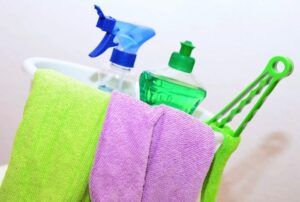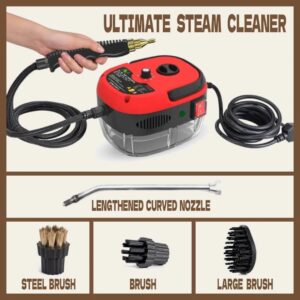
Kitchen degreasing tools are essential for maintaining a clean and hygienic cooking space. Whether you’re a professional chef or a home cook, these tools help in tackling tough grease and grime that accumulate over time. With various options available, understanding the right tools and techniques can make a significant difference in your kitchen cleaning routine.
From manual scrubbers to advanced electric degreasers, each tool is designed to cater to specific needs and surfaces. Knowing the materials used in construction and comparing manual versus electric tools can help you choose the best fit for your cleaning tasks.
Overview of Kitchen Degreasing Tools
In any kitchen, grease and grime are inevitable, especially when cooking involves oils and fats. Therefore, having effective kitchen degreasing tools is essential for maintaining cleanliness and hygiene. These tools vary widely in design and functionality, catering to different cleaning needs and preferences.Kitchen degreasing tools come in various forms, including sprays, wipes, scrubbers, and specialized electric devices. Each type is crafted from different materials that influence their performance.
For instance, many manual degreasers are made from durable plastics or metals, while electric devices might include high-quality stainless steel or high-impact plastics to withstand rigorous cleaning tasks. Understanding the characteristics and effectiveness of these materials can help users select the right tool for their specific cleaning tasks.
Types of Kitchen Degreasing Tools
There is an extensive range of degreasing tools available, each designed to tackle grease in unique ways. Here are some common types:
- Degreasing Sprays: These are commonly made with a blend of solvents and surfactants, which effectively break down grease. They are convenient for quick clean-ups and can be sprayed directly onto surfaces.
- Degreasing Wipes: Pre-moistened wipes are handy for spot cleaning and come in various formulations tailored to different types of surfaces, ensuring that grease is lifted away without scratching.
- Scrub Brushes: Typically made from nylon or natural fibers, these brushes are essential for scrubbing stubborn grease from pots, pans, and grill surfaces. Their bristles are designed to withstand tough scrubbing while remaining gentle on surfaces.
- Electric Degreasers: These devices, often equipped with heated elements or ultrasonic technology, can effectively break down grease without the need for manual scrubbing. They are particularly effective for cleaning items like deep fryers and greasy ovens.
Materials Used in Kitchen Degreasing Tools
The effectiveness of degreasing tools is significantly influenced by the materials used in their construction. Here’s a closer look at some common materials and their properties:
- Plastics: Many degreaser bottles and some scrubbers are made from high-density polyethylene (HDPE) or polypropylene, which are resistant to chemicals and durable under various cleaning conditions.
- Stainless Steel: Electric degreasers often incorporate stainless steel components for durability and ease of cleaning, as they resist rust and corrosion.
- Natural Fibers: Brushes with bristles made from natural fibers such as coconut husk or corn are biodegradable and effective for scrubbing without scratching delicate surfaces.
Comparison of Manual and Electric Degreasing Tools
Choosing between manual and electric degreasing tools depends on various factors such as efficiency, ease of use, and the type of cleaning required. Both have their advantages:
- Efficiency: Electric degreasers often provide a higher level of cleaning efficiency, especially for heavy-duty jobs. They can often work faster than manual methods, reducing cleaning time.
- Ease of Use: Manual tools require physical effort and technique, which can lead to fatigue, especially during extensive cleaning sessions. In contrast, electric tools require minimal physical effort and can often clean multiple surfaces at once.
- Cost: Manual tools are generally more affordable, while electric degreasers can be a more significant investment but may save money over time through reduced labor and cleaning supplies.
Choosing the right kitchen degreasing tools can significantly impact cleaning efficiency and effectiveness, ensuring a cleaner and healthier cooking environment.
Techniques for Effective Degreasing
When it comes to maintaining a clean and functional kitchen, effective degreasing is essential. Using the right techniques with degreasing tools can significantly enhance your cleaning efforts, ensuring your appliances and surfaces remain spotless. By understanding proper methods and strategies, you can remove grease and grime effectively, preserving the longevity of your kitchen equipment.Using different degreasing tools requires specific techniques to achieve optimal results.
Whether you’re dealing with a greasy stovetop, a grimy oven, or a heavily soiled hood, employing the right approach can make all the difference. Below are detailed methods for effectively using various degreasing tools.
Step-by-Step Guide for Cleaning Kitchen Appliances
Cleaning kitchen appliances can be a straightforward process if you follow a structured approach. Here’s a step-by-step guide for commonly used appliances:
1. Stovetop
Remove any detachable parts like knobs and burners.
Apply a degreaser directly onto the surface and let it sit for a few minutes.
Use a non-abrasive scrubber to gently scrub the surface.
Rinse with warm water and dry with a soft cloth.
2. Oven
Disconnect the power supply for safety.
Spray the interior with an oven-safe degreaser and allow it to penetrate for 15-20 minutes.
Wipe down with a damp cloth or sponge, focusing on stubborn spots.
Rinse thoroughly and dry before reconnecting power.
3. Range Hood
Remove the filters and soak them in warm, soapy water.
Spray the outside of the hood with a degreaser, allowing it to work for a few minutes.
Wipe the surface clean with a microfiber cloth.
Rinse filters under warm water, dry completely, and reattach.
4. Microwave
Place a bowl of water and a slice of lemon inside the microwave and run it for 5 minutes to steam.
Wipe down the interior surfaces with a sponge, using a mild degreaser for tough spots.
Rinse the sponge and wipe again with plain water to remove any residue.
This structured approach ensures that each appliance is cleaned effectively while minimizing the risk of damage.
Common Mistakes to Avoid When Using Kitchen Degreasing Tools
Understanding common errors can improve your cleaning routine significantly. Below is a list of frequent mistakes to avoid, along with practical solutions:
Using Too Much Product
Over-applying degreaser can lead to residue and waste.
Solution
Use the recommended amount as stated on the product label.
Neglecting Safety Gear
Not wearing gloves or masks when handling strong chemicals can be harmful.
Solution
Always wear appropriate protective gear to safeguard your skin and lungs.
Scrubbing Too Hard
Applying excessive force can scratch surfaces or damage finishes.
Solution
Use gentle pressure with soft scrubbers designed for cleaning.
Ignoring Directions
Skipping instructions may lead to ineffective cleaning or damage.
Solution
Always read and follow the instructions on the cleaning product.
Not Rinsing After Use
Failing to rinse off degreasers can leave harmful residues.
Solution
Thoroughly rinse surfaces with clean water after cleaning.By avoiding these pitfalls, you can enhance your kitchen cleaning efficiency and ensure your appliances remain in top shape for years to come.
Maintenance and Care for Cleaning Tools

To ensure that kitchen degreasing tools remain effective and last for years, it’s essential to prioritize their maintenance and care. Proper handling and storage not only enhance the longevity of these tools but also contribute to a more efficient cleaning process in the kitchen. By following best practices for upkeep and choosing the right products for cleaning, you can keep your kitchen environment both functional and eco-friendly.
Best Practices for Cleaning and Maintaining Tools
Regular cleaning and maintenance of kitchen degreasing tools are vital to their performance. Neglect can lead to buildup and damage that may compromise their effectiveness. Here are some key practices to consider:
-
Rinse Immediately After Use:
Always rinse degreasing tools right after use to prevent grease and grime from hardening, which makes it harder to clean later.
-
Use Gentle Cleaning Agents:
Opt for mild, non-abrasive cleaning agents that won’t scratch or damage the surfaces of your tools.
-
Dry Thoroughly:
After cleaning, make sure to dry tools completely to avoid rust or corrosion, particularly with metal items.
-
Inspect Regularly:
Check for wear and tear periodically. Replace worn-out parts or tools to maintain efficiency.
Safe and Effective Storage of Tools
Proper storage of kitchen degreasing tools not only keeps your kitchen organized but also protects them from damage. Consider the following methods for storing these items:
-
Use Tool Holder or Rack:
Installing a wall-mounted rack or pegboard can keep tools organized and off countertops.
-
Keep in a Designated Drawer:
Store tools in a specific drawer lined with a non-slip mat to prevent movement and scratches.
-
Separate by Function:
Group tools according to their use. For example, keep scrubbers with scrubbers and spray bottles with spray bottles to streamline your cleaning routine.
Importance of Eco-Friendly Cleaning Agents
Choosing eco-friendly cleaning agents is a responsible choice that benefits both your health and the environment. Many conventional cleaning agents are harsh and can leave harmful residues. Here are some eco-friendly alternatives:
-
Baking Soda:
A natural abrasive that effectively scrubs surfaces without toxic chemicals.
-
Vinegar:
Its acidity helps break down grease and acts as a natural disinfectant.
-
Lemon Juice:
Known for its natural acidity and pleasant scent, lemon juice can cut through grease and remove stains.
Using these eco-friendly options not only ensures a safer kitchen environment but also contributes to sustainability efforts by reducing chemical waste.
Concluding Remarks

In conclusion, mastering the use of kitchen degreasing tools not only enhances the cleanliness of your kitchen but also prolongs the life of your appliances. By following proper techniques and maintaining your tools, you can ensure a spotless and inviting cooking environment. Remember, a well-kept kitchen is the heart of delicious meals and memorable gatherings!
Q&A
What are the best materials for kitchen degreasing tools?
Stainless steel, silicone, and durable plastics are commonly used as they withstand heat and are resistant to corrosion.
How often should I clean my kitchen degreasing tools?
It’s best to clean them after every use to maintain hygiene and effectiveness.
Can I use kitchen degreasing tools on all surfaces?
While many tools are versatile, it’s important to check if they are suitable for delicate surfaces to avoid damage.
Is it necessary to use special cleaning agents with these tools?
Using eco-friendly cleaning agents is recommended for safety and to enhance the efficiency of degreasing tools.
What common mistakes should I avoid when using degreasing tools?
Avoid using too much force, as it can damage surfaces; also, ensure you follow the manufacturer’s instructions for best results.




